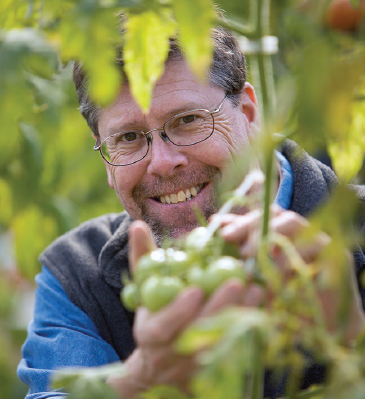Producing 100,000 pounds of food per year from a petite patch of infertile land is impossible. That’s exactly why Cullen Whitley is determined to do it.
In early 2012, Goodwill Industries of Eastern North Carolina received a plot of land as a living trust. Unfortunately for Goodwill’s goal of growing food for those in need, the property was in the Research Triangle Park. “RTP is out here because the land was deemed unfarmable,” Whitley said.
But he was just the man to prove that wrong. With a background in farming, he has helped start more than 70 community gardens in the last three years and made more than 200 presentations on farming practices in the last two. “I was hired to figure it out,” Whitley said, “which I have.”
Hired as farm manager in May 2012, Whitley used the blank slate of barren land to produce 22,000 pounds of food by year’s end. All foods produced from the farm are donated to the Food Bank, which allocates the fresh goods — blueberries, kale, herbs and sweet potatoes to name a few — to organizations like the Inter-Faith Food Shuttle.
A goal of 40,000 pounds for 2013 seems well within reach considering the farm had donated more than 10,000 pounds before the end of January. Have we mentioned that’s on a current lot of only 2 acres, and plans to double farming space are in the works?

Volunteers and staff work together to harvest tens of thousands of pounds of food from a 2-acre plot in RTP.
Whitley’s goal is sustaining 100,000 pounds of donations per year. So how does the farm produce so much with so little?
Ingenuity. “He has a plan for turning every square inch of that place that he can use to grow as much food as he possibly can,” said volunteer Merl Mangum, who brings his group, the Multi-Faith Friends for the Common Good, out to work one Sunday a month.
Space-maximizing techniques include straw-bale planting, crop rotation and vermicomposting, and even growing rice in drainage ditches. “People tell me I can’t do it, so that’s a good reason to do it,” Whitley said.
Sustainable green practices are important at the farm. All rainwater is collected for irrigation with an aim of water-sufficiency, and organic practices are also on the long-term to-do list. “This proactive approach is going to be needed across the board, from mom and pop operations to big operations,” he believes.
The farm is staffed by a handful of full-time workers assisted by numerous volunteers. Several dedicated volunteer days bring welcome help each month, or large groups can set up alternate days to lend a hand.

A little hard labor might do the body good, Mangum believes. “Getting our hands in the dirt connects us to reality. We have become detached,” he said. “It’s healing and healthy. Most people, when asked where food comes from, will say the grocery store.”
Even children as young as 2 have taken to the fields to get involved, Whitley says. “It’s a connecting thing for generations,” Mangum agreed. “They just dove in and had a blast.”
Volunteer opportunities at the farm don’t all involve getting dirty, however. An on-site warehouse serves as production center for disaster relief kits and is where Christmas stockings for Boys and Girls Clubs and other community support items are readied for distribution.

For volunteer schedules and additional information about the farm and other Goodwill programs, see goodwillenc.org.













